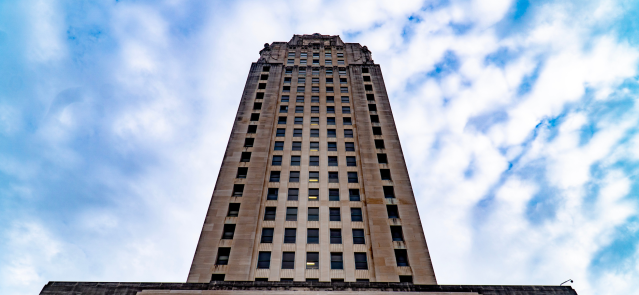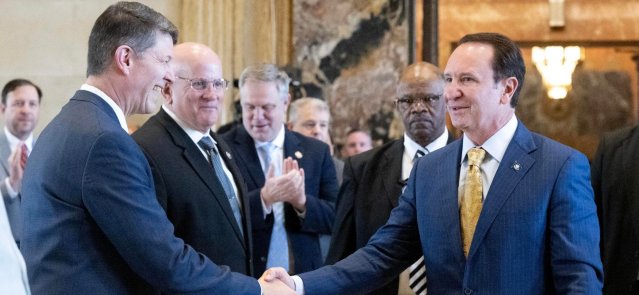Stay ahead of the curve as a political insider with deep policy analysis, daily briefings and policy-shaping tools.
Request a DemoOur History: Gen. Lafayette returns to Louisiana

A French hero of the American Revolutionary War made a grand visit to Louisiana in April of 1825.
Marie Joseph Paul Yves Roche Gilbert du Motier, Marquis de Lafayette was born in 1757. By age 12, he was a wealthy orphan, and he married into another wealthy family at 16.
At a dinner in 1775, according to this biography, Lafayette heard the Duke of Gloucester speak with sympathy about the ongoing struggle in the colonies. Thus inspired, he traveled to America and joined the revolutionary cause.
He was commissioned a major general in 1777, which reflected his wealth and noble social station, rather than battlefield experience. But Lafayette would distinguish himself in battle and was a staunch advocate for the Americans when he returned home.
In 1823, when the Legislature carved out a new parish from the western portion of St. Martin, it was named Lafayette in honor of the Frenchman, according to The Advocate. (The parish seat was called Vermilionville until 1884, when it was also named in Lafayette’s honor after a New Orleans suburb with the same name was incorporated into the city.)
At the invitation of President James Monroe, Lafayette returned to the United States on an official visit in 1824. All 24 states insisted on the honor of a visit, and Louisiana felt particularly entitled to see Lafayette because he was French.
On April 11, 1825, Gov. Henry Johnson and other dignitaries officially welcomed Lafayette to Louisiana at a historical battlefield in Chalmette.
Many Americans had opposed Louisiana’s statehood because of its French background. In his opening speech, Lafayette asserted, “In this state, daily evidence is given of the fitness of a French population for a wise use of free institutions and for self-government.”
New Orleans city leaders vacated the Cabildo, which was serving as City Hall, and dubbed it “General Lafayette’s House” for the duration of his stay, according to The Advocate. The council chambers became a reception room, the armory became a dining room, and officials’ private apartments were turned over to Lafayette and his entourage. A massive triumphal arch was erected out front on the Place d’Armes — 26 years before it was renamed Jackson Square.
When Lafayette visited Baton Rouge, the only place large enough to hold a reception for him was Madame Legendre’s two-story inn on the corner of Florida and Fourth Streets. After his brief visit, Second Street was renamed Lafayette Street, and legend has it that he delivered a speech from that street’s Tessier Building, also known as the Lafayette Building.
Notes 64 Parishes: “Ultimately, Lafayette’s visit to Louisiana underscored the obvious: The state was no longer foreign territory but had become truly part of the United States.”
This piece first ran in the March 28, 2024 edition of LaPolitics Weekly. Wish you could have read it then? Subscribe today!
Know the most important news affecting Louisiana
Get our free weekly newsletter that covers government, policy and politics that impact your everyday life—in 5 minutes or less.
Marusak: Federal regs, underfunding issues hinder Louisiana ports
Louisiana’s port system is the gateway into, and out of, the world. With more than 12,500 miles of waterways, our biggest economic driver – one in five jobs in the state – is at our backdoor. But the underfunding of projects necessary to feed the world, provide energy and keep the supply chain moving has …
Long-awaited DOTD reorganization report completed
LaPolitics/State Affairs has obtained the Boston Consulting Group report about the Louisiana Department of Transportation and Development. Gov. Jeff Landry tapped the Louisiana Coalition to Fix Our Roads, a private industry group, to initiate a planned reorganization effort for the department. The coalition selected BCG, which was expected to deliver the report to legislative leaders …
Our History: Louisiana’s first oil well
The first commercial oil well in Louisiana history was drilled in Evangeline (near Jennings) in September of 1901. Jules Clement, a French-speaking farmer, had noticed bubbles rising from a spot in one of his rice fields when it flooded. Knowing about the recent discovery of the Spindletop oil field in nearby Beaumont, Texas, he decided …
In Case You Missed it in LaPolitics Weekly
Here’s what you may have missed in the latest issue of LaPolitics Weekly, published last week… — TAX PLAN UNVEILED: Gov. Jeff Landry will have to navigate a political minefield to win approval of his proposed overhaul of Louisiana’s taxation system… — INSURANCE ISSUES: While some lawmakers and Commissioner Tim Temple continue to call for …




